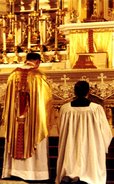Taken from WDTPRS
His Eminence Darío Card. Castrillón Hoyos delivered an address at the meeting of CELAM in Brazil.
Here are some of the good bits. My emphases. The less than smooth translation is not mine. I have fixed it in a couple places only.
Dear and venerated brothers:
I afford to present a brief report on the Pontifical Commission Ecclesia Dei and on the state of the pastoral reality that the Holy Father has put under its competence.
...Undoubtedly, the most important determination, which concerns the whole Church, is the search of putting an end to the schismatic action and reconstructing without ambiguities, full communion. The Holy Father, who was for some years a member of this Commission, wants that it become an organism of the Holy See with the proper and distinct purpose of maintaining and preserving the value of the traditional Latin liturgy. But it is necessary to affirm with all clarity that it is not an issue of turning back, of a return to the times previous to the reform of 1970. It is an issue, on the other hand, of a generous offer of the Christ’s Vicar who, as expression of his pastoral will, wants to put at the disposal of the Church all the treasures of the Latin liturgy that for centuries has nourished the spiritual life of so many generations of the catholic faithful. The Holy Father wants to preserve the immense spiritual, cultural and aesthetic treasures tied to the ancient liturgy. The recovery of this wealth joins to the no less beautiful of the current liturgy of the Church.
For these reasons the Holy Father has the intention of extending to the whole Latin Church the possibility of celebrating the Holy Mass and the Sacraments according to the liturgical books promulgated by Blessed John XXIII in 1962. For this liturgy, which was never abolished, and that, as we have said, is considered a treasure, a new and renewed interest exists today and also for this reason the Holy Father thinks that the time has come to facilitate, as the first Commission Cardenalicia had wanted it in 1986, the access to this liturgy, doing of her an extraordinary form of the only Roman rite.
There are some good experiences of communities of religious or apostolic life erected by the Holy See recently that celebrate in peace and serenity this liturgy. Around them there congregate assemblies of the faithful who frequent these celebrations with happiness and gratitude. The most recent erections are the Institute of Saint Felipe Neri in Berlin, which works as an Oratory and has become present also, with good reception, in the Diocese of Treveris; the Institute of Good Shepherd in Burdeos who gather priests, seminarians and faithful, some of them that have gone out of the Fraternity of San Pío X. The steps are very advanced for the recognition of a contemplative community, the Oasis of Jesús Sacerdote, in Barcelona.
In Latin America, since it is well-known, we must be grateful to the Lord for the return of a whole Diocese, that of Campos, earlier a Lefebvrian one, that now after five years, presents good fruits. It has been a pacific comeback and the faithful who have registered in the Apostolic Administration are glad to be able to live in peace in his parochial communities; even more, in fact some Brazilian dioceses have made contacts with the Apostolic Administration of Campos that has put at their disposal priests for the pastoral care of the traditionalist faithful in local churches. The project of the Holy Father has been already partially proved in Campos, where the pacific cohabitation of two forms of the only Roman rite in the Church is a beautiful reality. [YES!! side by side! Peaceful!] We have the hope that such a model produces good fruits, also in other places of the Church where both catholic faithful live with liturgical diverse sensibilities. And we hope, also, that such a way of living together should attract also those traditionalists who are still far.
The current members of the Commission are the Cardinals Julián Herranz, Jean-Pierre Ricard, William Joseph Levada, Antonio Cañizares, and Franc Rodé. The Undersecretaries of some Dicasterios are consultants.
Till now several dispersed communities in the world have been under Ecclesia Dei. 300 priests, 79 religious men, 300 religious women, 200 seminarians and several hundreds of thousands of faithful. Curiously, the interest of the young people in France, the United States, Brazil, Italy, Scandinavia, Australia and China are increasing. Since the moment of the return of Campos, 50 priests have passed, approximately fifty seminarians, 100 religious ones and 25.000 faithful.
Today the group of the lefevrist consists of 4 Bishops who were ordained by Mons. Lefebvre, of 500 priests and 600.000 faithful. Joined to the group are several contemplative monasteries and some religious masculine and feminine groups, they have parishes (they call them prioratos), seminars and affiliations. They are present in 26 countries.
Let’s ask the Lord that this project of the Holy Father could be realized soon for the unity of the Church.




No comments:
Post a Comment